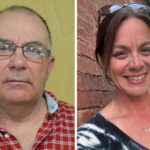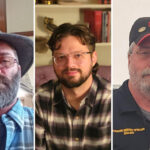Smyrna’s Kaufman sees demand for product expanding
By Gloria Austin
Staff Writer
SMYRNA – Making cheese at home launched a new business in Smyrna, the Sonnental Dairy, LLC. Pioneer Times Photo/Gloria Austin
Pioneer Times Photo/Gloria Austin
CHEESEMAKER — Robert Kauffman of Smyrna has been making cheese for two years, marketing his product along the coast of Maine and hoping locals will at least try his variety of cheese. After collecting the milk, Kauffman brings it back to his shop on the 277 Timoney Lake Road in Smyrna. Kauffman makes five different cheeses — Cheddar, Gouda, Baby Swiss, Colby and Pepper Jack — all using the same basic recipe.
“Necessity is the mother of invention,” laughed Robert Kauffman of the Amish community. “There was very little to do as far as farming to make a living up here, so we were trying to figure out ways to make a living on the farm. This is one way since I enjoy making cheese.”
Kauffman has been making cheese for two years, marketing his product along the coast of Maine and hoping locals will at least try his variety of cheese.
“I learned this from my home kitchen,” he said. “I went to a seminar in Kentucky and then an old master cheese maker originally from Wisconsin came up and spent a couple of days with me. This 82-year-old man taught me quite a bit.” Then last year, a cheese seminar was held in Smyrna with Vermont’s Peter Dickinson.
Then last year, a cheese seminar was held in Smyrna with Vermont’s Peter Dickinson.
“He spent two days teaching us,” Kauffman said. “We had people from all over the state come to the seminar.”
Cheese making is a complicated task.
“I hitch the horses and drive to my parents’ place where I get the milk from their farm three miles away,” he said. “I load it on the milk wagon and bring it home.”
His parents’ cows are certified organic and are grass fed most of the time, which Kauffman feels provides major health benefits of a grass-based diet.
After collecting the milk, Kauffman brings it back to his shop on the 277 Timoney Lake Road in Smyrna. He pours the milk into a holding tank, which is heated by a wood fire boiler. The hot water circulates through a jacket of the tank, heating the milk to 90 degrees.
With the milk ready, Kauffman adds his starter bacterial culture to begin souring the milk.
“It’s a little like souring wine,” he said.
As the cultures begin to work, Kauffman uses acid checkers to determine the timing for adding the rennet, a vegetable enzyme that causes coagulation.
“In about half-an-hour after adding rennet, I cut the mixture with big wire knives and metal cutters,” Kauffman said. “Then, I start heating it up again real slowly to 102 degrees, stirring slowly and gently because the curds are very soft and fragile.”
At this point, Kauffman is actually cooking the curd, causing the whey (liquid) to come out so the curd becomes drier.
“The whole purpose is to get the moisture at the proper level, while the acid bacterial culture is still working,” he said. “The starter bacterial culture is causing the proper acidity to develop, which causes the cheese to keep in the long run.”
In his cheese shop, Kauffman said he tries to use organic items and very little petroleum.
“The only hold up to being totally organic is the vegetable enzyme,” he explained. “I think I can find a vegetable enzyme that will work though. We also try to do everything as sustainable as possible, using as little petroleum products as we can. We do use gas motor for some things. We still are not completely away from petroleum, but I’d like to get a little farther away if I could.”
After the cheese is made, it is put into a cooling shed attached to the main shop. There are numerous wooden shelves piled with cheese bars among the several rows housing it, while it ages. The area is cooled by ice, which is collected through the winter. The ice house is surrounded by insulation to keep the ice from melting, while cooling the cheese cellar.
Kauffman makes five different cheeses — Cheddar, Gouda, Baby Swiss, Colby and Pepper Jack — all using the same basic recipe.
“The only difference is how much moisture I take out and how much I let the starter bacteria work,” he said.
Making cheddar cheese requires the most time at seven hours to make and then clean up afterward. Colby usually is done in four or five hours, with Baby Swiss being the least time consuming at four hours. “Then the aging process begins,” said Kauffman. “During the aging process, the bacteria cultures I introduced are still working, causing the breakdown of the cheese to make it nice and smooth, while allowing flavors to develop.”
“Then the aging process begins,” said Kauffman. “During the aging process, the bacteria cultures I introduced are still working, causing the breakdown of the cheese to make it nice and smooth, while allowing flavors to develop.”
Kauffman said that Cheddar cheese by far is his most popular.
“At two months, Cheddar is very mild and by six months, it’s getting some sharpness,” he explained. “At about a year old, it’s getting to where Maine people like it. Old-timers really like it at 18 months because they want it really sharp.”
So far though, Kauffman has been playing a guessing game at how to get people to try his product and where he can sell it.
“To get people to buy local when Vermont and California and other states have good cheeses, while also getting people to be willing to try something new has been a really challenge,” he said. “When they try it, they seem open to it.”
Most of Kauffman’s cheese has been transported to health stores along the coast of Maine.
“It’s been really hard because markets aren’t developed to a full point where I can still make the cheese and go find a market,” he said. “I’m gradually getting my market to shapen up, but it’s taken awhile.”
Right now, Kauffman isn’t set up to sell out of his shop, but is selling his product at a gift shop located near MAC’s Trading Post on the North Road.
“It eventually will happen,” he said. “I would be open to school children doing a tour if they would like. Just call to arrange it. If you can’t get a hold of me, keep trying.”
Kauffman can be reached at 757-7187 or at the Pioneer Place.







